Coconut, cactus, cooling nylon. These are just a few of the materials that fabrics are made from — and they’re inspired by today’s top fashions

Once upon a time, before the 19th century, cakes were served “naked.” They were just plain … white … cakes. Then bakers discovered they could mix sugar, egg whites and flavoring, and voila — icing! Not only did icing add to the attractiveness of the cake, but it also enhanced the flavor and the experience of eating it. Today we can’t imagine a cupcake without buttercream frosting on top. Just like we can’t imagine a mattress without the fabulous fabric on top — the ticking. And today it’s much more than just a functional outer cover — it’s a fashion statement.
According to the Culp Home Fashions website: “While it was originally designed in the blue and white stripe commonly known by the name today, ticking comes in a range of shades, styles and materials. Today, there is an increasing consumer demand for a variety of colors and patterns on the borders and trim of mattresses, as well as foundations. Mattresses and box springs are now seen as an extension of the furniture in the room, which should reflect the style of the consumer.”
Not only must modern ticking manufacturers focus on the fashion, but they must also make sure the technology is in place for their fabrics to perform. Today’s consumers expect their top of beds to be cooling and comfortable, while also antimicrobial and sustainable.
Natural & Sustainable
It’s almost impossible to talk with any ticking company without hearing their plans for sustainability. With textiles among the most difficult parts of the mattress to recycle, producers are digging deep to use natural materials in addition to recycled polyester and organic cotton.
Of all the introductions from Kayseri, Turkey-based Boyteks Tekstil, vegan mattress ticking was the most popular at ISPA EXPO 2022, says Aydin Aydin, brand director. In fact, its ticking placed in the top 20 for Innovative Furniture Accessory at Interzum Guangzhou in China. It’s not tested on animals, and it does not contain products derived from animal sources. Vegan mattress ticking also is environmentally friendly and ecological, according to Aydin.

of mattress ticking.
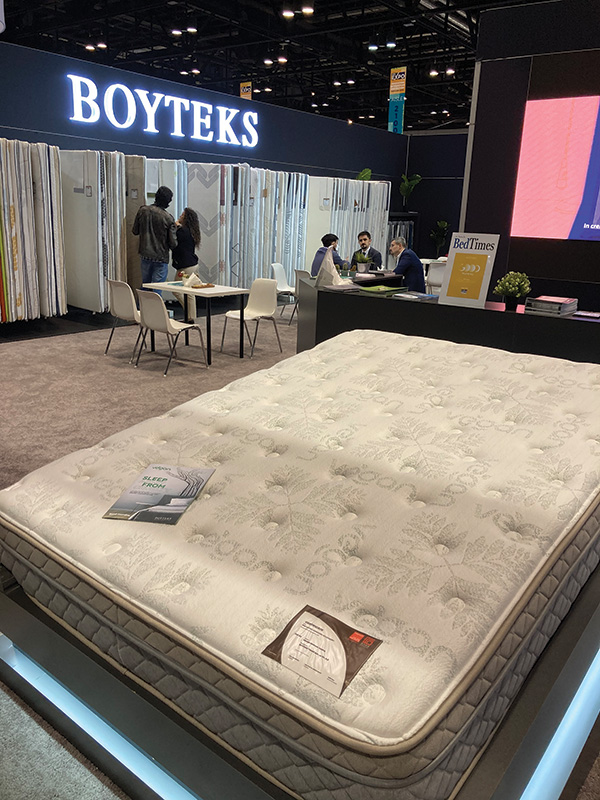
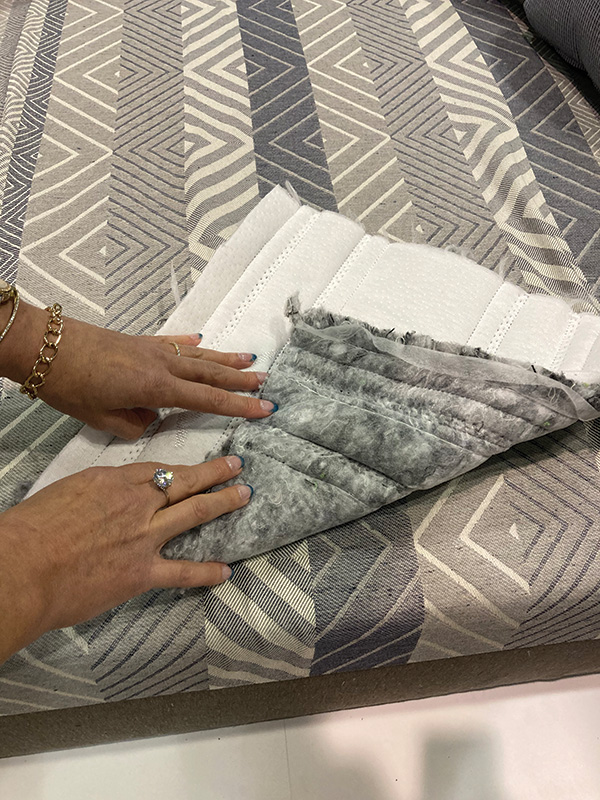
CT Nassau uncovered new quilting materials taken from the waste on its production floor. The quilting process is ultrasonic, so there are no threads; the material is melted together and different patterns are possible.
In another innovative twist, Wielsbeke, Belgium-based Lava Textiles introduced Zoë: a combination of cotton and Tencel fibers extracted from wood taken from sustainable forestry plantations.
“This has received many awards for its eco-friendly manufacturing process,” according to Amy Stennett, Lava vice president. “Tencel fibers are produced in a closed loop system whereby chemicals are recovered and reused. Tencel also has excellent moisture properties. The fibers absorb moisture extremely quickly and release it away from the body, improving your sleep comfort.”
At Istanbul-based Aydin Tekstil, recycled coconut shells take on new life. “We now have coconut fabric that was produced with coconut-based yarn,” says Hilal Aykas, regional sales manager of mattress ticking. “It’s a natural yarn, and the colors are really cool, like pinks and grays.”
Called Cococo, Aydin’s coconut mattress fabric is produced from yarns made by transforming the activated carbon structure from coconut shells into fiber. These fibers help to keep the body dry and possess antibacterial and deodorizing properties, according to an Aydin brochure.
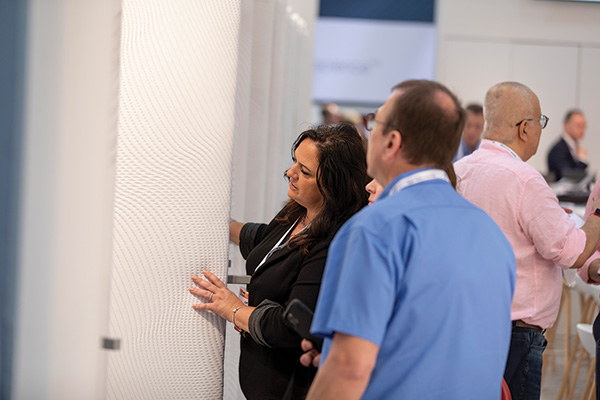
Finally, Alamance, North Carolina-based fabric supplier CT Nassau uncovered new mattress quilting materials from the waste on its production floor. “There are two developments here,” says Valerie Hellebuyck, design lead for North America. “First, it’s a quilting process with no yarn. It’s ultrasonic, so it looks like seams, but there are no actual threads. It’s melted together, and you can do different types of patterns.
“Then, it’s the fact we’re re-using our own waste,” she continues. “It’s a new development, and we are checking with customers to see if they are interested in these types
of products.”
Fashionable & Bridal
More and more ticking designers are taking their cues from the runways, while at the same time, the mattress itself is becoming known as its own piece of furniture.
“Our inspiration is our fashion and apparel background,” says Maxime Thériault, general manager of Montreal-based Maxime Knitting. “We do high-end ladies wear at our company. We work with haute couture brands — so how can we bring that creative, that haute couture, to bedding? How can we bring our background in haute couture and sell it to a mattress consumer and have that reaction, ‘Wow, it’s a nice piece of furniture and not just a white bed.’”
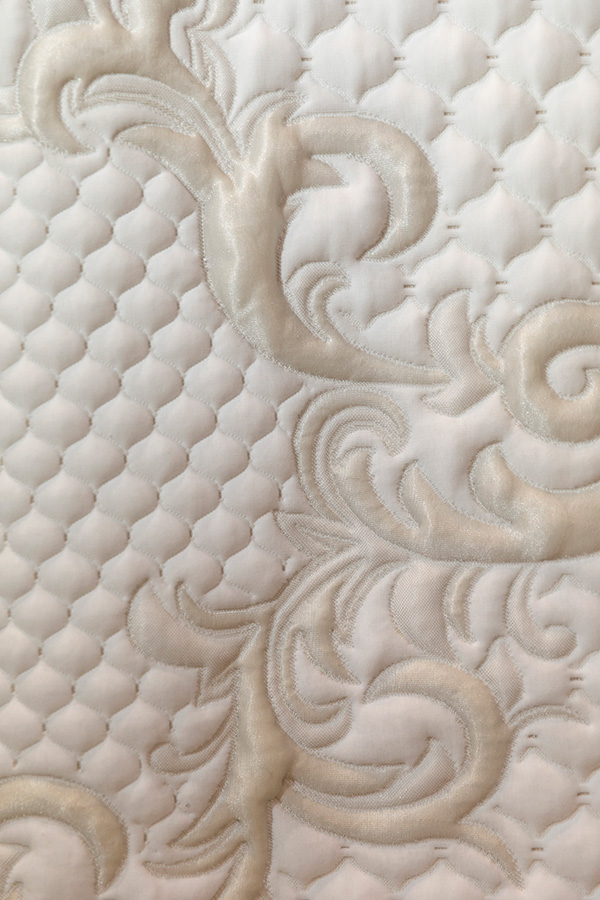
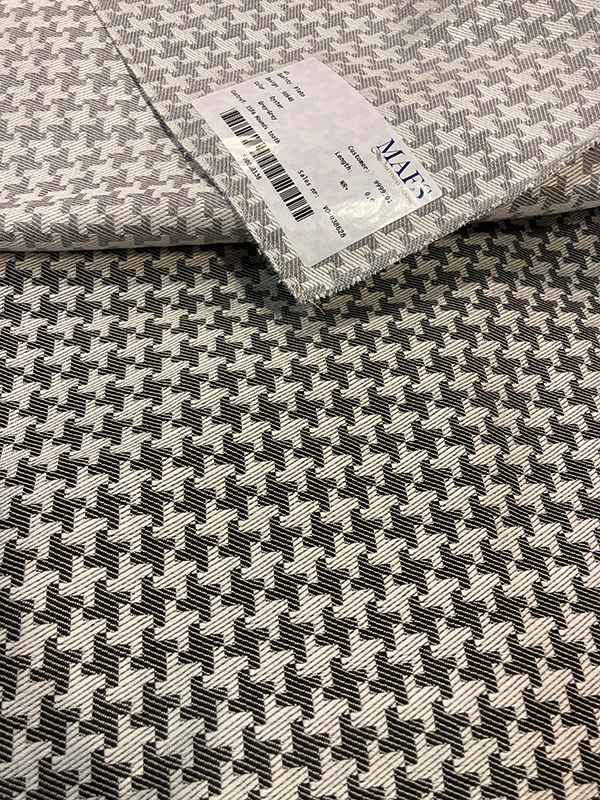
Zwevegem, Belgium-based Maes Mattress Ticking follows interior design ideas in combination with fashion, according to Bart Desmet, vice president of business development. Take its new range of houndstooth border fabrics. “Our spin-off houndstooth looks more like jigsaw puzzle pieces, and the traditional looks more like squares. That’s the riff taken from fashion and translated into a proper woven mattress ticking — it could be a jacket,” Desmet says.
Meanwhile, High Point, North Carolina-based Culp Home Fashions found inspiration from Chanel for its new bridal ticking line, with fabrics that could double as the bodice of a wedding gown. “My inspiration is the runway,” says Christina Pennant, creative director. “My world prior to mattress was fashion and it’s always been my first love. This is inspired by Chanel, our bridal collection. In terms of texture mixing, this is Chanel, with champagne highlights.”
It’s no surprise that mattress ticking is taking a stroll down the aisle, as mattresses and bedding are becoming more popular items for wedding registries. “We saw many weddings being postponed during the pandemic, so there is a huge number of new events coming up this year,” says Charlene Vaz, design and marketing director for BekaertDeslee North America. “We have a theme just for this type of consumer.”
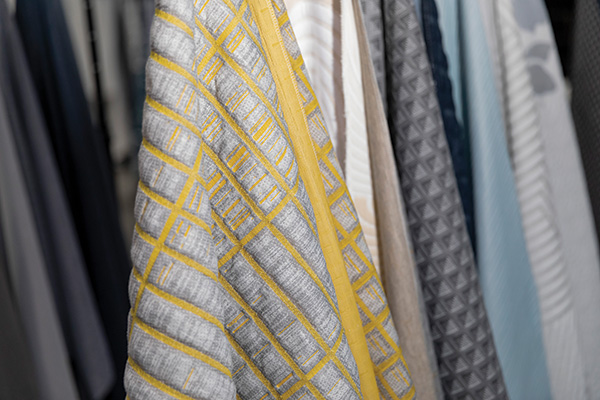
evoke the new futuristic trend, inspired by technology.
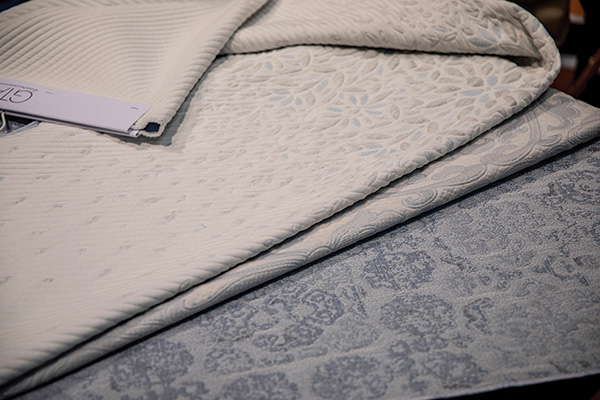
As part of the new Neo fabric collection, the Re-connect theme focuses on “re-connecting with yourself and those you hold dearest,” according to the company’s website. “In the wedding fabrics, for example, we have our classics, but we’re being inspired by a laser-cut style to have a digital touch,” Vaz adds. “So, here we have the white with dark grays to lend drama and romance to the fabric; it gives it a dramatic flair.”
Futuristic & Digital
On its website, Waregem, Belgium-based BekaertDeslee describes the Neo fabric collection as “where the grid of digitalization meets the grid of reality,” which brings us to the new futuristic trend, inspired by technology (see Trend Talk on page 42).
The Restart theme within the Neo collection focuses on creating sporty designs through movement and technical distortion. “Just like in the real world and the digital world, all you need sometimes is a good reboot to get your system working like it should.”
For Maxime, it’s a striking, geometric look. “This is the digital trend, and people like it very much,” says Joanna Zarate, Maxime designer. “I think it’s a showstopper. It’s very bold and it’s very different and that’s what people are looking for. The colors are refreshing — we’re using these bluish colors, a sort of blue lagoon effect with some greens.”
Its new avant-garde styles in its Digital Trace collection feature a 3D effect to lend a sense of depth and dimension to the mattress. “This is very futuristic,” says Olesya Kuzhel, Maxime textile designer for apparel. “It projects the universe and infinity.”
Meanwhile, BekaertDeslee approached botanical designs by viewing nature through a virtual lens with its Neo Rejoice theme. “We don’t have well-defined leaves, but very textured digitalization, with other types of colors such as blues and grays,” Vaz says. “So, it’s not only green leaves, but keeping the textures of digitalization, and we’re calling this theme ‘hyper-nature.’”
In its Scoop publication, the company defines hyper-nature: “Feathery foliage, technological looks, blurred effects, unbuilt shapes and hazy appearances are being mirrored in the digital platform. Hyper-saturated tones animate plants. Digital collages and imaginary florals are a must-have for otherworldly dreamscapes.”
Modern & Traditional
Maes translates modern differently than some might: It is taking a traditional fabric and reinvigorating it for the future. “We still make the original Belgian damask but with a modern touch, a modern approach, which is a rarity in the industry,” Desmet says. “There are not a lot of people still making Belgian damask.”

The Restart theme in BekaertDeslee’s Neo collection focuses on sporty designs through movement and technical distortion.
Why not do both modern and traditional? Global Textile Alliance splits the difference with two separate collections. First, the Traditional collection finds inspiration in florals, antique rug patterns and lace, with a soft hand. Colors include Serene, Aloe and Thistle.
“We knew we wanted it to be feminine in spirit and that the color needed to be very livable,” says Susan Hedgecock, creative director of bedding for the Reidsville, North Carolina-based company. “We wanted it to be integrated into someone’s bedroom and not feel like we’re bringing an athletic shoe into a soft, pretty bedroom.”
In contrast, its Modern collection embraces opposites: light and dark, positive and negative, high and low. “Some styles look like a barcode or a key punch,” Hedgecock says. “We have some designs that are big scale and M.C. Escher-ish with very arresting graphics. The color is very dark and saturated, but still has a tint of color. It’s blue and teal mixed.”
Color Story
“From a trend standpoint, we have rose gold and dark saturated neutrals that give an alternative to gray,” Hedgecock says. “And we’ve shifted to a warmer neutral with a touch of pink in it. We intentionally as a brand responded to all the different types of consumers and their aesthetics.”
By far the most dominant colors are still white and gray for mattress ticking, but more colors are weaving their way onto the bed.
BekaertDeslee contends that color will be a key tool in 2023. “The metaverse will expand virtual worlds, enabling new forms of self-expression, and color will play a central role,” according to its Scoop publication. “Expect hues that are transformative, making an impact in both digital and physical realms.”
Its color palette includes cobalt, umber, violet, teal, gray and a candy-hued pink.
In WGSN’s Trend Talk (see page 42) at ISPA EXPO, Warren Satchell, consultant and director, predicts that Orchid Flower purple will pave the way. “This is WGSN’s color of the year, and it mixes nature with technology, and it adds a dose of optimism,” Satchell says. “As the pandemic was unfolding, this intense magenta hue captured a vivacious appetite for joy and positivity. As consumers adjust post-pandemic, stimulating colors will have a strong appeal, inciting feelings of optimism and vigor. Orchid Flower’s hyper-real nature makes it appealing both in real life and in digital applications.”
Aydin’s Aykas noted that more customers are requesting color. “During EXPO, I saw that people wanted to see some different colors, like pinks and grays, and lilacs and grays; on cool fabrics, blue and white are still popular,” Aykas says. “Normally in the U.S., white and blue, and white and gray, and some mélange gray colors, and white and black are all popular. But people are glad to see different colors.”
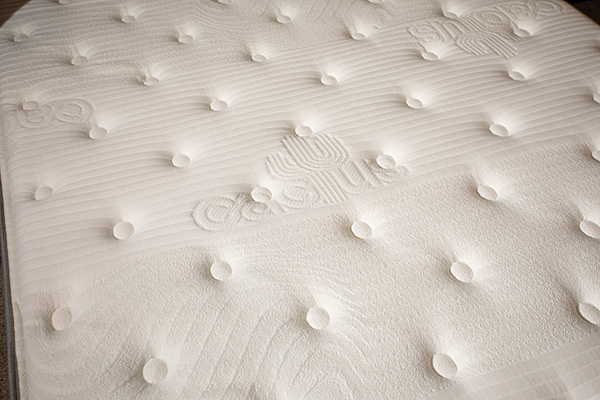

Borderline
If you think the top panel of the mattress is the only important visual element — think again.
“The focus needs to be on the border because when you walk into a showroom you see the border first,” says Linda Duncan, vice president for Duncan Ticking, based in Oklahoma City. “It’s more eye-catching and also there’s more yardage sold in the border than in the topper.”
The border also is a place to play with color. “Our clients still want white tops and black and gray sides, or white tops with some charcoal in the toppers and borders,” Duncan says. “Then there’s some upholstery-look borders and small pattern borders. They use a different product on the topper and on the border.”
Camilla Franklin agrees. She’s the vice president of design and marketing for Creative, based in Gastonia, North Carolina. “We’ve got a lot of borders, which are really important on the bed, and should never be an afterthought,” Franklin says. “It’s what you come to first as you’re walking up. It’s what you see from afar. You must have something to grab the eye.”
In Creative’s case, that’s a new textured border. “The fabric actually came from our automotive division,” Franklin says. “We fell in love with it because it has an upholstery feel, and it’s got a box pleat with a little peek-a-boo element.”
Performance
No matter how stylish or on-trend or well-designed the ticking might be, it doesn’t matter if it doesn’t perform well on the bed. In recent years, fabrics must be both cooling and hygienic. And there’s also attention on FR solutions — which is a focus for Creative.
“There’s definitely interest on the health side, and obviously with Covid, there was a big boost to any kind of antimicrobial fabric,” Franklin said. “I’d say that’s a strong third requirement after cooling and sustainability.”
Creative offers a CoolZone fabric, and it’s working with MicroBan on an antimicrobial line. They also recently introduced FR Flame Fence Eco protection by TIO Tec, used in a full-wrap engineered cover, which brings savings to the cover by avoiding the use of an FR sock, according to Franklin.
Culp features a line of cooling fabrics, but now they don’t have to be white — the company recently started using blues to denote cooling. Another innovation: placing FR on the backs of fabrics, in addition to providing fabrics that work well with an FR sock.
Burlingame, California-based Standard Fiber provides a variety of solutions related to hygiene, ranging from microencapsulated probiotics for a natural solution to anti-microbial/antibacterial finishes for hospitality and institutional applications.
“For those of us in the textile world, we have been thrilled with all the publicity surrounding how important sleep is to one’s overall health and wellness,” says Brandon Wells, executive vice president and general manager of the mattress division. “It has really allowed us to innovate and bring new performance technologies to our customers. Mattress ticking is no longer just the decorative wrapping of a mattress. It is part of the overall sleep system.”
Wells says that Standard Fiber is seeing tremendous growth in fabrics containing polyethylene yarns and cooling nylon. The company also offers finishing treatments, even bio-based, that increase evaporation and heat absorption.
“Cooling has been involved in the mattress segment for many years,” Wells says. “I think what has changed is that it is now expected to be in our textiles at certain levels. It is no longer an add-on, but instead a baseline for medium to upper-end price points.”
Boyteks has found a new and unexpected way to manage moisture and provide cooling: cactus mattress ticking. “We launched it this year, and we are using cactus water,” Boytek’s Aydin says. “What’s the advantage of the cactus mattress ticking? It has huge moisture management.”
So much innovation, so much design, so much time, effort and energy on manufacturing fabrics that can, literally, do it all, from keeping you cool to helping the environment.
That’s today’s ticking, and that’s the icing on the cake.




